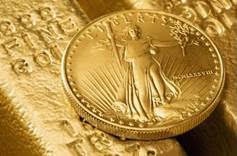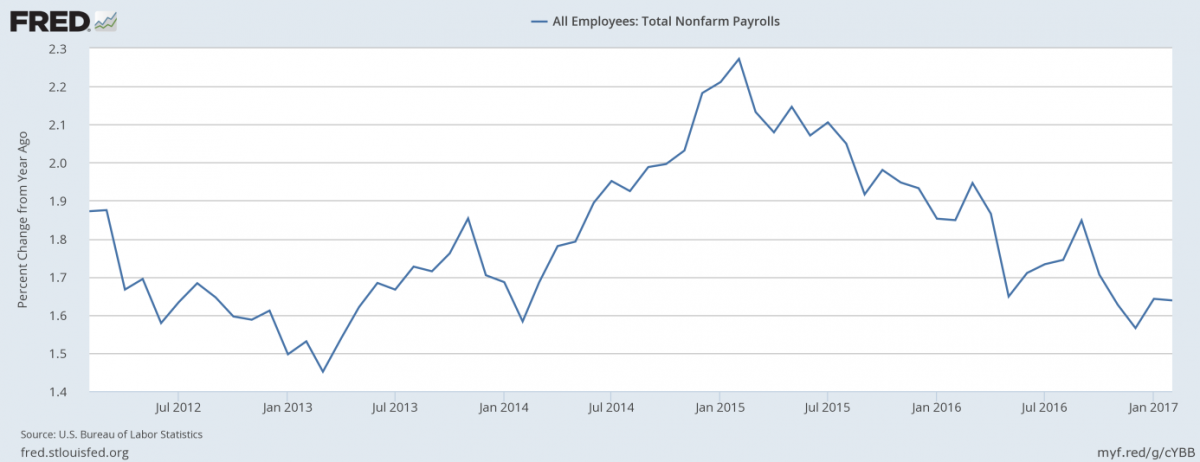February Payrolls And Gold

The US economy added 235,000 jobs in February. What does it mean for the gold market?
Job Gains Strong in February
The total nonfarm payroll employment jumped 235,000 in February, following 238,000 in January, according to the U.S. Bureau of Labor Statistics. Analysts had expected 200,000 jobs created. Thus, the actual number was significantly above expectations. Moreover, employment gains in December and January combined were 9,000 higher than previously reported. It means that job gains in the last three months have averaged 209,000, significantly higher than last month. Gains were concentrated in education and health services (+62,000), construction (+58,000) and professional and business services (+37,000). Retail trade reduced 26,000 jobs, while employment in utilities and information was little changed.
Hence, job gains were strong in February, signaling further improvement in the US labor market. Indeed, the chart below shows that there was a reversal in the annual pace of employment growth in January, while the US labor market has strengthened further in February, which should convince the Fed that an interest rate hike is warranted this week.
Chart 1: Total nonfarm payrolls (percent change from year ago) over the last five years.
Other Labor Market Indicators
Other labor market indicators were also positive. The unemployment rate edged down from 4.8 percent to 4.7 percent. Both the labor force participation rate and the employment-population rate rose 0.1 percentage point to, 63 and 60 percent, respectively. Moreover, the average wage in the private sector increased 6 cents to $26.09, after rising 5 cents in January. It means that the hourly pay jumped 2.8 percent over the year. Hence, the employment report cleared the way for the Fed to raise interest rates at its meeting this week.
Payrolls, Fed And Gold
The US economy continued to create jobs at a nice pace, the hourly earnings rose, while the unemployment rate declined slightly reflecting the fact that more people entered the labor force. Therefore, the latest data on the labor market took away the last hurdle to a Fed hike in March. Indeed, the upward move this week is practically certain, at least according to the market odds, which rose from 88.6 to 93 percent on Friday.
Hence, the release of the report should be a negative development for the yellow metal, at least theoretically. However, the price of gold increased initially in the aftermath of the publication, just as one month ago. Thus, it seems that the February report did not provide any new information and there was short-covering, which supported the gold market. Or investors expect now that the price of the yellow metal will rally after the Fed hike. It may be also the case that markets just focused on Draghi’s hawkish comments from Thursday.
The key takeaway is that February employment gains were strong and signaled that the U.S. labor market really started the year on a reasonably solid footing. Now, it almost certain that the Fed will lift interest rates this week. The hawkish tone adopted by the President of the ECB in Thursday’s press conference also set the stage for a Fed hike in March. Despite strong employment data, gold managed to rise on Friday. It signals that the market sentiment remained strong – investors may expect a replay from December 2015 or December 2016, when gold prices rallied after the Fed hike. We cannot exclude such a scenario, but investors should take all analogies with a pinch of salt, since a lot has changed since that time. For example, before previous interest rates hikes the markets expected that gold would decline. It’s often the case that prices go opposite to the widespread expectations, so please be aware and stay tuned!
Disclaimer: Please note that the aim of the above analysis is to discuss the likely long-term impact of the featured phenomenon on the price of gold and this analysis does not indicate (nor does it aim to do so) whether gold is likely to move higher or lower in the short- or medium term. In order to determine the latter, many additional factors need to be considered (i.e. sentiment, chart patterns, cycles, indicators, ratios, self-similar patterns and more) and we are taking them into account (and discussing the short- and medium-term outlook) in our trading alerts..
Arkadiusz Sieron
Sunshine Profits‘ Gold News Monitor and Market Overview Editor



















